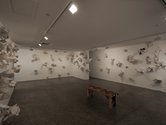John Hurrell – 30 June, 2012
The fact that this is indoors introduces a slightly shocking aspect. We rarely experience architectural disorder inside when buildings are functioning properly and engineered soundly because we are used to the ‘safe' stability of horizontal and perpendicular lines. Experiencing jumbled tumbling chunks of plank in a curved space just above head-height is disorienting. We worry about crashing into something.
Gregor Kregar is probably best known for his ceramic sheep and geometric wall sculptures with shiny metallic triangular surfaces. Recently he spent two weeks running a workshop for 300 pupils at Elm Park Primary School and the drawings and folded paper sculptures the children made when considering their own ‘Dream House Project’ are on show in one of Te Tuhi galleries.
This interaction was valuable because it sowed seeds for Kregar’s own installation in the main foyer gallery (the large space between the cafe and the offices just inside the entrance) an improvised work constructed from scrap timber found in a huge mound at the dump, offcuts he eventually transformed into a wooden ‘dwelling’ like three igloo-shaped huts butted together.
Inside, with its fanning arched columns and curved ceilings, it is oddly reminiscent of late Gothic cathedrals. In a vague, sort of stunted way, because this low construction is assembled with just nails - with the wooden batons and bits of floorboards spread apart. There are lots of gaps so the extemporaneous architecture becomes porous, like a kind of net that lets the dappled light and some air through. It is not a functioning shelter but a darkened cavelike space for contemplation, a tree hut you don’t have to climb up into. From a distance and back it looks like a huge striding animal.
In its construction Kregar’s installation is a lovely combination of regimented control and chaos. Structurally it is rock solid while also appearing extremely casual. It is firmly attached to the walls of the Te Tuhi building and so one wonders if Kregar did an outdoors version in a field, how different might it be? If abandoned to the forces of nature, how might winding plants, nesting birds and the occasional rodent transform it?
The fact that this is indoors introduces a slightly shocking aspect. We rarely experience architectural disorder inside when buildings are functioning properly and engineered soundly because we are used to the ‘safe’ stability of horizontal and perpendicular lines. Experiencing jumbled tumbling chunks of plank in a curved space just above head-height is disorienting. We worry about crashing into something.
In my view this show presents Kregar at his best. It is miles more interesting than his dealer gallery shows. He is far better thinking holistically about a spatial intervention than making smaller discrete sculptures. Here he spontaneously deals with arising structural opportunities by using an organic relaxed style. Inviting artists like him to do things in such a public and busy entrance is for a Te Tuhi a bold gamble. If the results are regularly as successful as this, long may it continue.
John Hurrell









 Two Rooms presents a program of residencies and projects
Two Rooms presents a program of residencies and projects Advertising in this column
Advertising in this column



This Discussion has 0 comments.
Comment
Participate
Register to Participate.
Sign in
Sign in to an existing account.